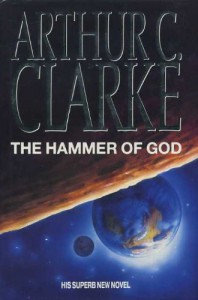 Originally reviewed at Bookwraiths Reviews
Originally reviewed at Bookwraiths ReviewsI was at my local public library trying to sign up for e-book service (Don’t get me started on how annoying that was) when I stumbled upon this book. As I began reading, I wondered how I had missed this novel back in the 90s. This was answered within two chapters, however, when I realized I had read this back in the day and just forgotten about it.
The premise of The Hammer of God is (drum roll please) an steroid on a collision course with Earth. And yes, there have been several novels exploring this same premise and also a couple movie released in 1998. (For those keeping track, the movies were Deep Impact starring Robert Duvall and Morgan Freeman and Armageddon directed by Michael Bay, produced by Jerry Bruckheimer, and headlined by a star-studded cast including Bruce Willis, Ben Affleck, Billy BobThornton, Liv Tyler, and Owen Wilson.)
Mr. Clarke’s novel is a bit different from the normal disaster, end-of-the-world story or movie in that it spends the majority of its time following the life of our main character, spaceship-captain Robert Singh. Singh appears to be a normal man of his times, and we explore that time through his life. We are shown his youth as an athlete competing in a marathon race on the Lunar surface. We are watch as Singh reminisces about his first love and his first child being born on a technocrat controlled Earth of 3 billion people. From there, we follow Robert Singh to the colony on Mars, which is gradually terra forming the Red Planet, and we even touch upon his time as a bored space captain. Interspersed among our life story of Robert Singh is plenty of narrative about Earth history, the evolution of technology, religion, and society, and the how of Earth’s plan to protect itself against the fate of the dinosaurs: extinction by asteroid strike.
Eventually, Mr. Clarke gets around to talking about our ominous asteroid of death: Kali it is named. The how and why of Kali’s existence is touched upon, and we then are given a brief story of Goliath, Singh's ship, emergency voyage to rendevous with Kali. The narrative briefly describes the construction and operation of a special thruster used on Kali to nudge its orbit a tiny bit so as to make it miss Earth, and - since this is a novel, not a scientific paper - Mr. Clarke throws several problems at Robert Singh and the crew of the Goliath to complicates their task and make it a more interesting story.
All in all, this was a decent novel, but it was not a great one by any stretch. Mr. Clarke writes at the end that The Hammer of God began its existence as a short story, and it probably should have remained one, because it seemed stretched out for no practical purpose except to relay more scientific information. Also, the difficulties encountered by Singh and his ship seem impractical and somewhat ridiculous though they did add a small amount of drama. No matter its faults, however, I will admit that the moments when Robert Singh contemplates his past and speaks about his first love and his first child being the most precious times of his life were poignantly written and did touch a chord with me. For that reason and the science it imparts, I’m glad I “rediscovered” this book.


